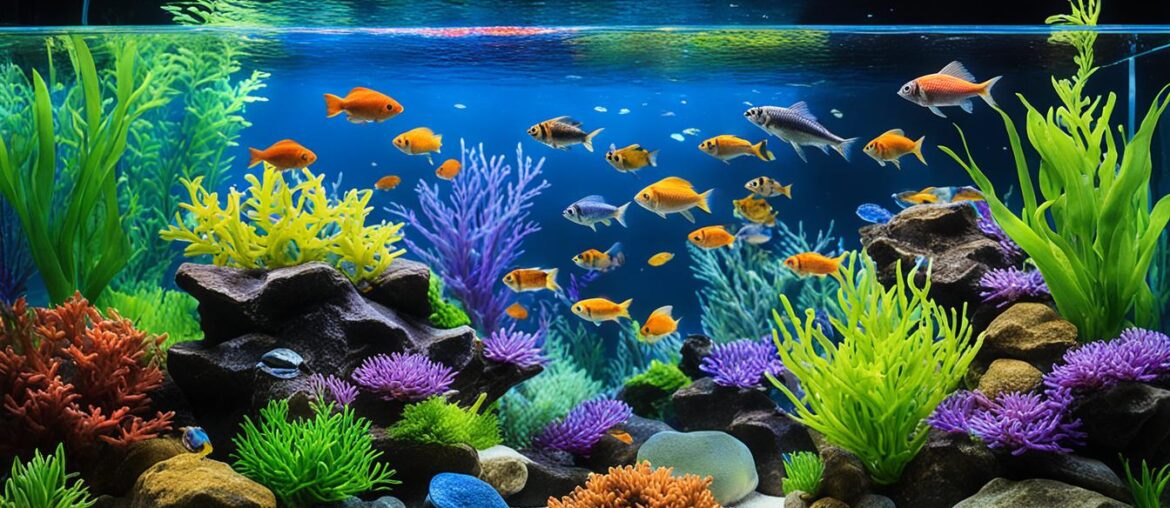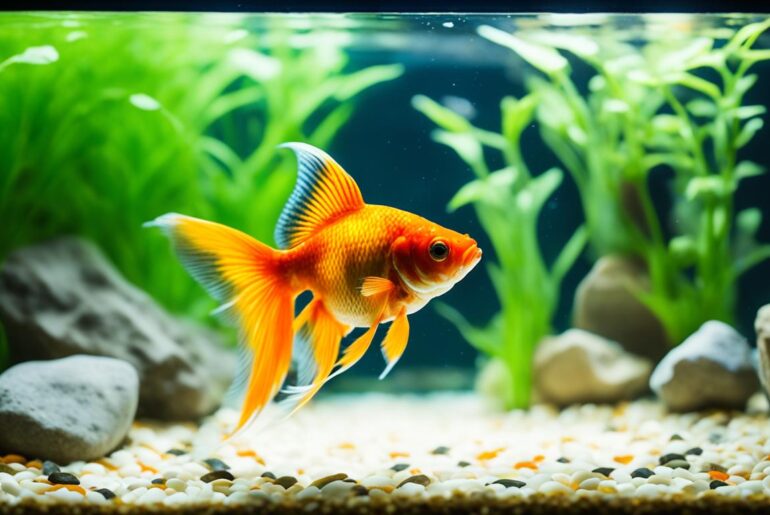Are you wondering how many freshwater aquarium fish you can properly keep in your tank? The traditional rule of thumb suggests 1 inch of fish per gallon of water, but is this still accurate? In this comprehensive guide, I will explore the ideal fish stocking levels and provide you with the information you need to create a thriving aquatic environment for your beloved fish.
Many factors come into play when determining the number of fish per gallon that is suitable for your aquarium. It’s not just about the space, but also the specific needs and characteristics of the fish species you want to keep. By understanding these factors and making informed decisions, you can ensure the well-being of your fish and create a harmonious tank environment.
Key Takeaways:
- Stocking fish based on the traditional rule of 1 inch per gallon is outdated and may not provide optimal conditions for your fish.
- Consider factors such as the species of fish, their size, and their compatibility with other fish in your tank when determining stocking levels.
- Use fish tank capacity guidelines or a fish tank stocking calculator to help you determine the appropriate number of fish for your tank size.
- Research the specific requirements of the fish species you plan to keep to ensure they have enough space to thrive.
- Seek expert advice to make informed decisions and create a balanced and healthy environment for your fish.
Factors to Consider When Stocking Your Aquarium
When stocking your aquarium, there are several factors that you should consider. These include the size of your aquarium, the species of fish you plan to keep, and their compatibility with each other. It is important to choose fish that have similar water quality tolerances and dietary needs. Additionally, you should take into account the growth potential of your fish and provide a tank that is large enough for them to reach their full size without being cramped.
Using an aquarium fish tank size calculator or a fish tank stocking calculator can be helpful tools in determining the appropriate number of fish for your tank size.
Remember, a happy and healthy fish is a fish that has enough space to grow and thrive in its environment.
Now, let’s explore some of the key considerations when stocking your aquarium:
Aquarium Size
The size of your aquarium plays a crucial role in determining the number of fish you can comfortably keep. The volume of water in the tank directly affects the oxygen and waste management capabilities of the aquatic environment. In general, a larger tank provides more stable water conditions and allows for a greater number of fish. However, each fish species has different space requirements, so it is important to research the specific needs of the fish you plan to keep.
Species Compatibility
When selecting fish for your aquarium, it is essential to consider their compatibility with each other. Some fish species are more aggressive and territorial, while others are peaceful and prefer to live in groups. Mixing incompatible fish can lead to stress, aggression, and even injury or death. Researching the temperament and behavior of different species will help you create a harmonious community in your tank.
Growth Potential
Another factor to consider is the growth potential of the fish you plan to keep. Many fish species grow significantly larger than their juvenile size, and providing enough space for their full growth is essential. Crowding fish in a small tank restricts their movement and can lead to stunted growth and other health problems. Be sure to research the adult size of your chosen fish and provide a tank that can accommodate their future dimensions.
Water Quality and Filtration
Maintaining good water quality is crucial for the health and well-being of your fish. Poor water conditions can lead to stress, diseases, and even death. Proper filtration, regular water changes, and monitoring water parameters such as temperature, pH, and ammonia levels are vital to create a stable and thriving aquatic environment. The capacity of your tank’s filtration system should be able to handle the bio-load produced by your fish.
By considering these factors and using the right tools, such as an aquarium fish tank size calculator or a fish tank stocking calculator, you can ensure that your aquarium is well-stocked and provides a healthy and enjoyable home for your fish.
| Factor | Description |
|---|---|
| Aquarium Size | Determine the appropriate tank size based on the needs of your chosen fish species. |
| Species Compatibility | Research the temperament and behavior of different species to ensure compatibility. |
| Growth Potential | Consider the adult size of your fish and provide a tank that can accommodate their future dimensions. |
| Water Quality and Filtration | Maintain optimal water conditions through proper filtration and regular monitoring. |
The Importance of Fish Size and Body Type
Fish come in various sizes and body types, and these characteristics are crucial factors to consider when stocking an aquarium. The maximum size that a fish species can reach determines the space it requires in a tank. Providing ample room for the fish to grow is essential for their overall health and well-being. Additionally, the body type of a fish can affect its territorial behavior and space requirements. Some fish are more active and require a larger swimming area, while others are more sedentary and can thrive in smaller tanks.
Using an aquarium stocking density calculator or referring to a fish tank gallonage chart can help determine the appropriate number of fish based on their size and body type. These tools provide valuable insights into the optimal stocking levels for different fish species, ensuring a balanced and comfortable environment for all inhabitants.
Here is an illustrative example of the impact of fish size and body type on stocking density:
| Fish Species | Maximum Size (inches) | Body Type | Recommended Tank Size (gallons) |
|---|---|---|---|
| Neon Tetra | 1.5 | Active | 10 |
| Angelfish | 6 | Semi-aggressive | 30 |
| Oscar | 12 | Aggressive | 75 |
| Goldfish | 8 | Vegetative | 20 |
As seen in the table above, the recommended tank sizes vary according to the maximum size and body type of each fish species. Providing adequate space based on these factors ensures the well-being of the fish and maintains a harmonious aquatic environment.
Remember, understanding the unique characteristics of each fish species before stocking your aquarium is essential for creating a thriving and balanced ecosystem.
Considerations for Different Fish Species
When it comes to stocking your freshwater aquarium, it’s essential to take into account the specific needs and requirements of different fish species. Each species has its own preferences when it comes to tank size and stocking levels. Understanding these considerations will help you create a suitable environment for your fish to thrive.
Behavior, Diet, and Compatibility
One crucial aspect to consider is the behavior of the fish species you plan to keep. Some fish are more active and may require more space to swim and explore, while others are calmer and can adapt well to smaller tanks. Take note of their feeding habits as well, as some species may have specific dietary requirements that could dictate the size of the tank needed to maintain a healthy ecosystem.
Additionally, consider the compatibility of different fish species. Some fish are more aggressive and territorial, while others are more peaceful and may be suitable tankmates with a wider range of species. Make sure to research the compatibility of the fish you intend to keep and provide enough space for each species to establish its territory.
Size and Space Requirements
The size of the fish you plan to keep is another crucial factor to consider. Some species can grow quite large and will require larger tanks to accommodate their size. It’s important to research the maximum size that each species can reach and ensure that your aquarium can accommodate their growth without overcrowding.
Furthermore, different fish species have varying space requirements. Some species prefer open swimming areas, while others require hiding spots or areas with dense vegetation. Providing adequate space and appropriate tank features will ensure that your fish have a comfortable and stimulating environment.
| Fish Species | Tank Size (in gallons) |
|---|---|
| Guppy | 10 |
| Angelfish | 30 |
| Discus | 40 |
| Oscar | 55 |
| Goldfish | 20 (per fish) |
| Neon Tetra | 5 (school of 6+) |
Use this table as a guideline to determine the recommended tank size for specific fish species. However, it’s important to note that individual requirements may vary, so always research the specific needs of each species.
Remember, creating a suitable environment for your fish is essential for their health and well-being. By considering the behavior, size, and space requirements of different fish species, you can ensure that your aquarium provides the ideal conditions for your aquatic friends.
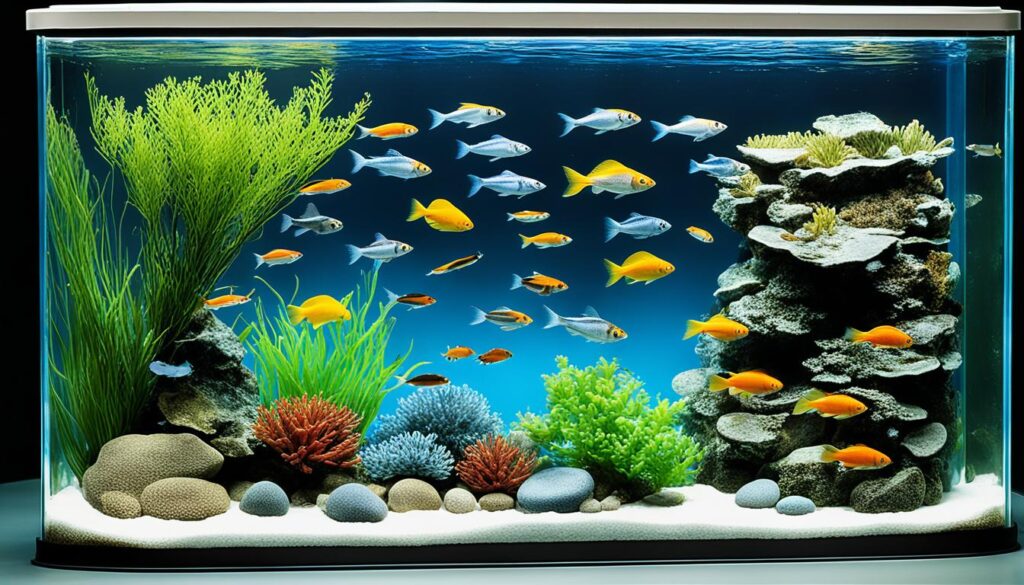
The Role of Experience Level in Stocking Fish
As an aquarium owner, your experience level plays a significant role in determining the appropriate number of fish to keep in your tank. Your level of familiarity with fishkeeping and your ability to maintain optimal water conditions directly impact the success of your fish stocking decisions.
For beginners, starting with a larger tank can provide more stability and forgiveness for any mistakes in water quality or maintenance. A larger tank can also allow for a more forgiving fish stocking approach, giving you room to learn and adjust as you gain experience. However, it is still important to consider the needs of the fish species you plan to keep and ensure that they have enough space to thrive.
Remember, learning about fish stocking is a journey, and it’s okay to start small and gradually expand your collection as you become more comfortable and knowledgeable.
Experienced hobbyists who are well-versed in the intricacies of fishkeeping may be able to keep multiple species in smaller tanks, provided they have the knowledge and resources to maintain optimal water conditions. These experienced individuals have a deeper understanding of the specific requirements of different fish species and can create suitable environments even in limited tank sizes.
When assessing your own experience level, it is vital to be honest with yourself and consider your capabilities and limitations as an aquarium owner. If you are starting out, focus on building your knowledge and skillset before taking on more complex stocking arrangements.
The Importance of Research and Education
Regardless of your experience level, investing time in research and education is crucial for successful fish stocking. Understand the specific needs of the fish species you plan to keep, including their compatibility, dietary requirements, and tank size preferences. This knowledge will provide you with valuable insights into the optimal number of fish for your tank.
Tools like the Aquarium Stocking Density Calculator and the Fish Tank Stocking Calculator can assist in determining the appropriate fish stocking levels based on your tank’s capacity and the needs of your fish species.
Remember, being a responsible aquarium owner means prioritizing the well-being and health of your fish. Always strive to create an environment where they can thrive, regardless of your experience level.
| Experience Level | Tank Size Considerations | Research and Education |
|---|---|---|
| Beginner | Starting with a larger tank for stability and forgiveness | Learn about the specific needs of your chosen fish species |
| Experienced | Ability to maintain optimal conditions in smaller tanks | Extensive knowledge of different fish species and their requirements |
| All Levels | Honest assessment of capabilities and limitations as an aquarium owner | Use resources like stocking calculators and seek expert advice |
Regardless of your experience level, with the right knowledge and a commitment to proper care, you can create a thriving aquatic environment that benefits both your fish and your enjoyment as an aquarium enthusiast.
The Impact of Tank Shape on Fish Stocking
When it comes to stocking your aquarium with fish, the shape of the tank can have a significant impact. Fish prefer horizontal swimming space, and tanks that provide more length rather than height are often more suitable for certain species. By considering tank shape alongside tank capacity, you can ensure that your fish have enough space to swim and thrive.
Additionally, the shape of your tank can affect the placement of accessories and decorations, which in turn can have an impact on the overall stocking capacity of the aquarium. Carefully arranging these elements is essential to create an aesthetically pleasing environment while ensuring that your fish still have plenty of room to move around.

When selecting a tank shape, keep in mind the specific needs of the fish species you plan to keep. Some species may require ample swimming space due to their active nature, while others may be more comfortable with smaller territories. Understanding the behavior and activity level of your fish will help you determine the most suitable tank shape for their needs.
| Tank Shape | Suitable Fish Species |
|---|---|
| Rectangular Tank | Tetras, Guppies, Angelfish |
| Bow Front Tank | Danios, Rasboras, Corydoras |
| Cylinder Tank | Betta fish, Dwarf Gouramis |
| Cube Tank | Shrimp, Snails |
Choose a tank shape that not only accommodates the size of your fish but also provides them with enough room to exhibit their natural behaviors. This will help to ensure the well-being and happiness of your aquatic companions.
The Importance of Tank Setup for Fish Stocking
When it comes to stocking your aquarium with fish, the setup of your tank plays a crucial role. The presence of live plants, rocks, and driftwood can impact the number of fish you can comfortably keep.
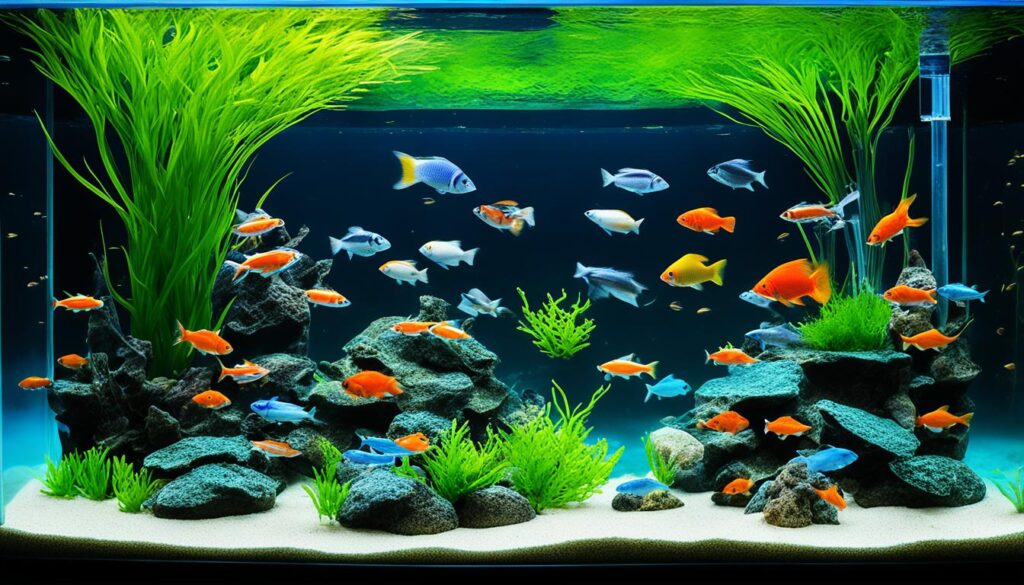
Live plants provide additional surface area for beneficial bacteria to grow, creating a healthy environment for your fish. These plants help maintain water quality by reducing the bioload in your tank.
Rocks and driftwood not only add aesthetic appeal to your aquarium but also serve a functional purpose. They provide hiding places and additional territory for fish, reducing stress and promoting natural behavior. However, it’s important to consider the space occupied by these elements when determining the stocking capacity of your tank. Fish still need enough room to swim and thrive.
“The presence of live plants, rocks, and driftwood can greatly enhance the habitat of your aquarium and provide a more natural environment for your fish.” – Aquarist Magazine
Fish Tank Setup Guidelines
| Element | Benefits |
|---|---|
| Live plants |
|
| Rocks |
|
| Driftwood |
|
By carefully considering the setup of your aquarium, you can provide a more natural and enriched environment for your fish. This not only enhances their overall well-being but also contributes to a visually stunning aquatic display.
Water Quality Considerations for Fish Stocking
Ensuring optimal water quality is essential when stocking your aquarium with fish. Different fish species have specific requirements for temperature, pH level, and water hardness. To maintain a healthy aquatic environment, it is crucial to meet these specific conditions. Failure to do so can result in stress, illness, and even death for your fish.
The Freshwater Fish per Gallon Rule
One popular guideline for stocking fish is the freshwater fish per gallon rule. This rule suggests that you should allocate one gallon of water per inch of fish. However, it is important to note that this rule is outdated and not universally applicable.
Aquarium Stocking Density Calculator
For a more accurate assessment of stocking levels, consider using an aquarium stocking density calculator. These online tools take into account various factors such as fish size, species, and activity level, providing a more precise estimate for your specific setup.
Monitoring Water Parameters
Regularly monitoring water parameters is crucial for maintaining optimal water quality. Test kits are available to measure temperature, pH level, ammonia, nitrite, and nitrate levels. By keeping these parameters within the appropriate range for your fish species, you can prevent potentially harmful conditions and ensure their well-being.
Avoid Overstocking
Overstocking your aquarium can lead to increased waste production, resulting in higher ammonia and nitrate levels. This can cause stress and health problems for your fish. It is vital to resist the temptation to overcrowd your tank and instead maintain a suitable stocking level based on the specific requirements of your fish.
| Water Quality Parameter | Ideal Range | Key Considerations |
|---|---|---|
| Temperature | Depends on fish species | Fish have specific temperature preferences, research the needs of your chosen species |
| pH Level | Varies by fish species | Some fish prefer acidic water, while others thrive in alkaline conditions |
| Water Hardness | Depends on fish species | Consider the hardness of the water your chosen fish species require |
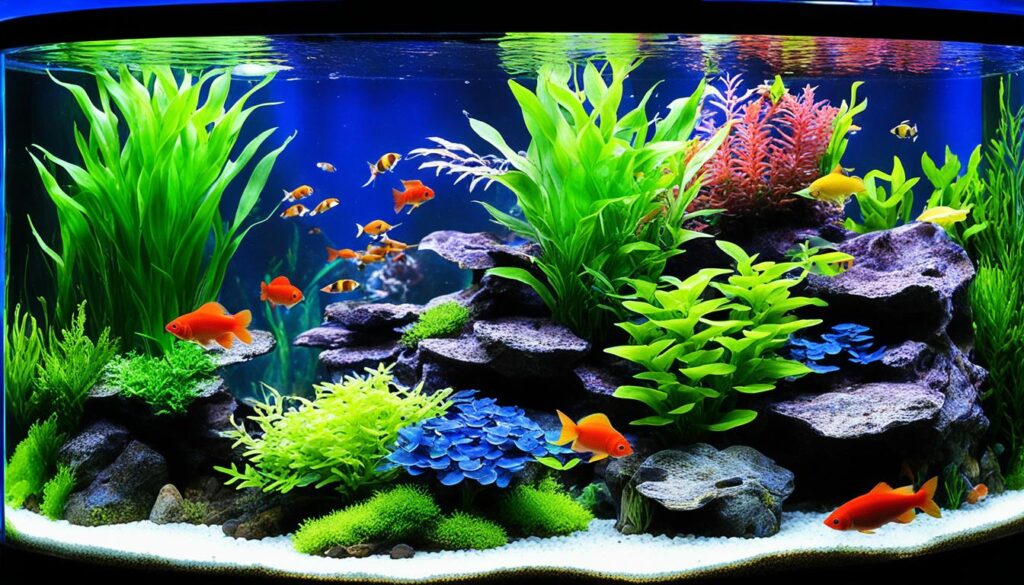
Expert Advice for Fish Stocking
When it comes to fish stocking, seeking expert advice is always a smart move, especially if you’re a beginner or unsure about the specific requirements of your chosen fish species. Consulting with a local fish veterinarian or visiting a reputable pet store with knowledgeable staff can provide you with valuable insights and guidance.
These experts can help you determine the ideal fish stocking levels for your tank size and the compatibility of different species. They have the expertise to assess factors such as the size of your aquarium, the needs of the fish, and their behavior to ensure you make informed decisions.
Additionally, these professionals can guide you in creating a suitable environment for your fish to thrive. They can provide advice on water quality, filtration systems, and tank setup that will promote the health and well-being of your aquatic pets.
Remember, expert advice is an invaluable resource that can help you avoid common pitfalls and set you on the path to success in your fish stocking journey.
Why Seek Expert Advice?
Expert advice is crucial because fish stocking is not a one-size-fits-all approach. Every fish species has unique requirements and needs. By consulting with knowledgeable individuals, you can gain insights into the specific needs of your chosen fish and create an optimal environment for them to flourish.
These experts have experience with a variety of fish species and can provide recommendations based on their practical knowledge. They can advise you on the appropriate number of fish for your tank size, considering factors such as territorial behavior, swimming space requirements, and compatibility.
The Benefits of Local Fish Veterinarians and Reputable Pet Stores
Local fish veterinarians and reputable pet stores are great resources when it comes to seeking expert advice for fish stocking. Here’s why:
- Local fish veterinarians possess specialized knowledge about fish health and are familiar with various fish species. They can provide guidance on disease prevention, nutrition, and tank maintenance.
- Reputable pet stores with knowledgeable staff can offer practical advice on fish stocking. Store employees often have firsthand experience with different fish species and can share their expertise to help you make the right decisions for your aquarium.
When you visit these experts, be prepared with specific questions about your fish species and tank setup. This will help facilitate a more productive and informative conversation.
Remember, the goal is to create a thriving and harmonious aquatic environment for your fish. Expert advice is an essential component in achieving that goal.
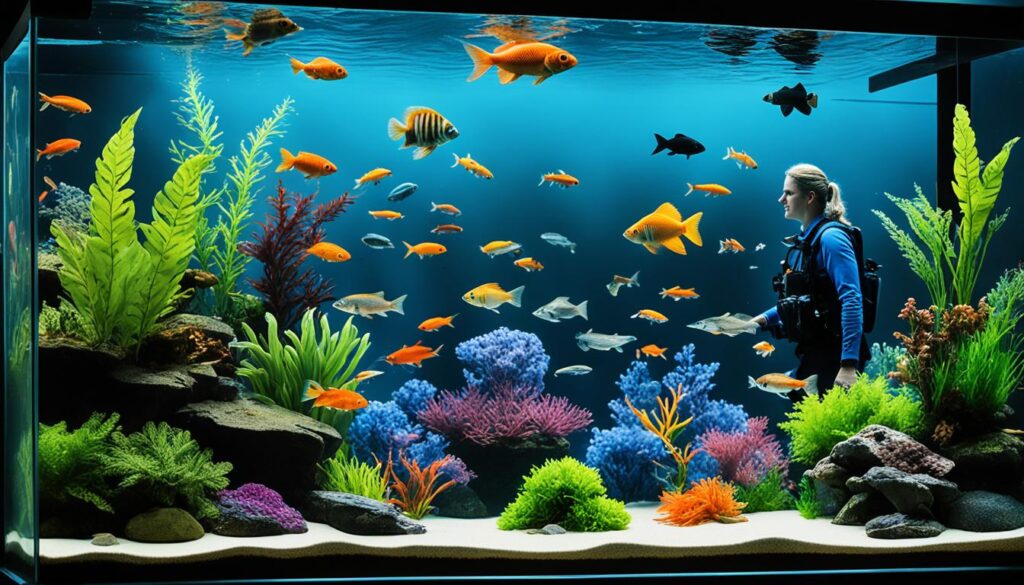
In Summary
Expert advice is invaluable when it comes to fish stocking. Consulting with local fish veterinarians and knowledgeable pet store staff can provide you with the guidance and insights needed to make informed decisions. Their expertise can help you determine the ideal fish stocking levels for your tank size and the compatibility of different species. By seeking expert advice, you can create a suitable environment for your fish to thrive and enjoy a rewarding aquarium keeping experience.
Conclusion
Stocking your freshwater aquarium with fish per gallon is a complex process that requires careful consideration of various factors. By taking into account the size and body type of the fish, their specific needs, water quality, and your own experience level, you can create a thriving aquatic environment.
Researching the individual requirements of the fish species you plan to keep is crucial. Various tools, such as fish tank stocking calculators and fish tank capacity guidelines, can assist you in determining the optimal number of fish for your tank size.
Additionally, seeking expert advice from local fish veterinarians or knowledgeable pet store staff can provide invaluable guidance. Their insights can help you make informed decisions about fish stocking and ensure that you create a balanced and healthy environment for your fish to thrive.
Remember, following the recommended guidelines and providing a suitable environment for your fish is essential. With proper research, the right tools, and expert advice, you can enjoy a vibrant and harmonious freshwater aquarium with happy and healthy fish.
FAQ
What is the traditional rule for stocking fish in an aquarium?
The traditional rule of thumb is 1 inch of fish per gallon of water, but this rule is outdated and not comprehensive.
Why is the traditional rule of stocking fish considered outdated?
The traditional rule does not take into account the specific needs and characteristics of different fish species.
How can I determine the appropriate number of fish for my aquarium?
Factors to consider include the size of your aquarium, the species of fish you plan to keep, their compatibility, and their specific requirements.
Are there any tools available to help me calculate the number of fish I can keep in my aquarium?
Yes, you can use an aquarium fish tank size calculator or a fish tank stocking calculator for guidance.
How does the size and body type of fish affect the stocking capacity of an aquarium?
Fish size and body type play a role in determining the space requirements and territoriality of fish in an aquarium.
What should I consider when stocking my aquarium with different fish species?
Consider the behavior, diet, and compatibility of the fish species, and provide an appropriate environment for each species.
Does my experience level as an aquarium owner impact fish stocking decisions?
Yes, beginners may find it easier to start with a larger tank for stability, while experienced owners may have more flexibility in stocking options.
How does the shape of my aquarium affect fish stocking?
Fish prefer horizontal swimming space, so tanks with more length than height are often more suitable for certain species.
Does tank setup affect the number of fish I can keep?
Yes, factors such as live plants, rocks, and driftwood can impact the stocking capacity by occupying space and influencing fish behavior.
Why is water quality important when stocking fish in an aquarium?
Different fish species have specific water quality requirements, and overstocking can lead to increased waste production and potential health issues.
Should I seek expert advice when stocking fish in my aquarium?
Yes, consulting with a local fish veterinarian or knowledgeable pet store staff can provide valuable guidance for fish stocking decisions.
